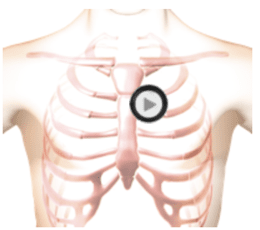Pulmonic Regurgitation - Mild Auscultation Lesson with Recordings
Virtual Auscultation


The patient's position is sitting leaning forward.
Lesson
This is an example of mild pulmonic regurgitation which can be caused by an infection of the pulmonic valve leaflets. The first and second heart sounds are normal (S2 is split). Systole is silent. A high-pitched decrescendo murmur occupying the first half of diastole can be heard starting immediately after the second heart sound. The murmur is best heard at the pulmonic area and can be accentuated by having the patient sitting up and leaning forward. The intensity of the murmur increases with inspiration, indicating the right-sided origin of the murmur. In the animation you can see the turbulent blood flow from the pulmonary artery into the right ventricle during early diastole. You can see the minimally thickened pulmonic valve leaflets.Waveform
Heart Sounds Video
Authors and Sources
Authors and Reviewers
-
Heart sounds by Dr. Jonathan Keroes, MD and David Lieberman, Developer, Virtual Cardiac Patient.
- Lung sounds by Diane Wrigley, PA
- Respiratory cases: William French
-
David Lieberman, Audio Engineering
-
Heart sounds mentorship by W. Proctor Harvey, MD
- Special thanks for the medical mentorship of Dr. Raymond Murphy
- Reviewed by Dr. Barbara Erickson, PhD, RN, CCRN.
-
Last Update: 12/11/2022
Sources
-
Heart and Lung Sounds Reference Library
Diane S. Wrigley
Publisher: PESI -
Impact Patient Care: Key Physical Assessment Strategies and the Underlying Pathophysiology
Diane S Wrigley & Rosale Lobo - Practical Clinical Skills: Lung Sounds
- Essential Lung Sounds
Diane S. Wrigley, PA-C
Published by MedEdu LLC - PESI Faculty - Diane S Wrigley
-
Case Profiles in Respiratory Care 3rd Ed, 2019
William A.French
Published by Delmar Cengage - Essential Lung Sounds
by William A. French
Published by Cengage Learning, 2011 - Understanding Lung Sounds
Steven Lehrer, MD
- Clinical Heart Disease
W Proctor Harvey, MD
Clinical Heart Disease
Laennec Publishing; 1st edition (January 1, 2009)